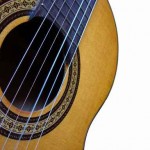 When should we introduce the theory behind identifying the notes in a chord & behind moveable chords?
When should we introduce the theory behind identifying the notes in a chord & behind moveable chords?
Unlike those who deal with “theoretical physics”, in guitar class we deal with practical, not “theoretical”, chords. As soon as students have a reasonable grasp of the basic I IV V7 cowboy chords, their attention can be directed to why a G chord is a G chord. Our fingers are fretting the notes G, B, D, G, B and G. If we discard the duplicates we are left with G,B, D. If we fret a C chord our fingers fret a C, E, G, C and E. Again, discarding duplicates we have C,E, G. Is there a pattern here?
Approaching “theory of chords” as a “hands on” activity on the guitar rather than paper, brings a relevancy and immediacy to the concept of building chords. As they encounter dominant 7 and extended chord forms the students will then have a practical, stronger foundation upon which to build. Relating this chord construction awareness back to reading lead sheets, the students can easily grasp the more sophisticated concepts of melodic and harmonic analysis.
[social_button button=”facebook” furl=”http://www.facebook.com/pages/Teaching-Guitar-Workshops/98983006090″ flayout=”standard ” fshow_faces=”on” fwidth=”450″ faction=”like” fcolorsheme=”light”]
